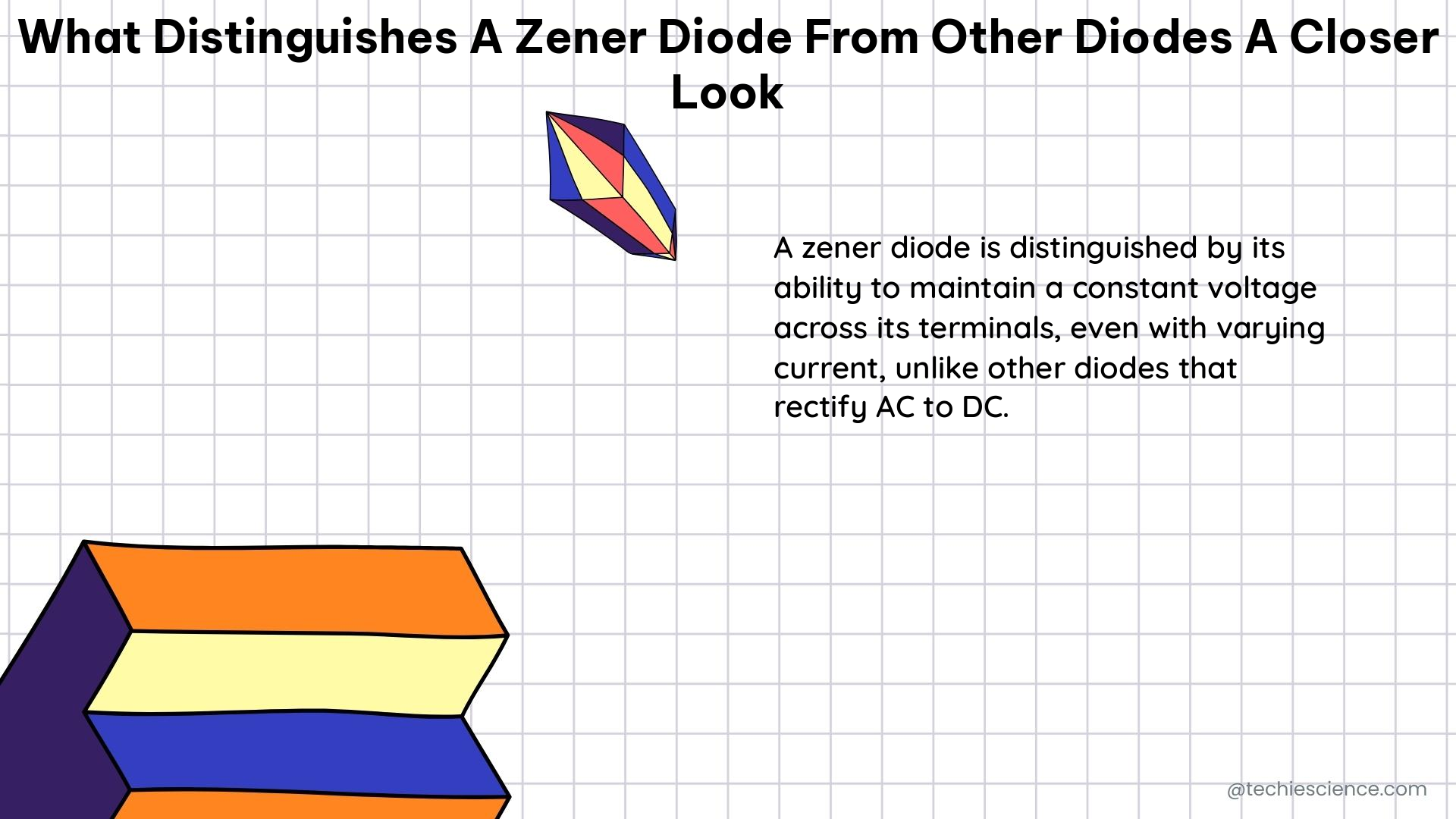Zener diodes are a unique type of semiconductor device that operate in the reverse-bias region, allowing them to regulate voltage and maintain a constant voltage level across the diode. This sets them apart from other diodes, such as rectifying diodes, which are designed to operate in the forward-bias region and allow current to flow in only one direction.
Breakdown Voltage (Zener Voltage)
One of the key characteristics that distinguishes Zener diodes from other diodes is their breakdown voltage, also known as the Zener voltage (Vz). This is the voltage at which the diode begins to conduct current in the reverse-bias direction. In a Zener diode, the breakdown voltage is carefully controlled during the manufacturing process to be a specific value, typically ranging from 2.4V to 200V.
This precise control of the breakdown voltage is what allows Zener diodes to regulate voltage and maintain a constant voltage level across the diode, even when the input voltage varies. In contrast, rectifying diodes have a much higher breakdown voltage, typically in the range of several hundred volts, and are not designed to operate in the reverse-bias region.
Current-Voltage (I-V) Curve

Another key characteristic that distinguishes Zener diodes from other diodes is their current-voltage (I-V) curve. The I-V curve is a graph that shows the relationship between the current flowing through the diode and the voltage across the diode.
In a Zener diode, the I-V curve is characterized by a sharp “knee” at the breakdown voltage. This means that as the voltage across the diode increases, the current flowing through the diode increases sharply at the breakdown voltage. This sharp increase in current is caused by the Zener effect, which is a quantum mechanical effect that occurs when the voltage across the diode is sufficient to create a large electric field that causes electrons to be ejected from the valence band of the semiconductor material.
In contrast, rectifying diodes have a much more gradual I-V curve in the forward-bias region, with the current increasing smoothly as the voltage increases. In the reverse-bias region, the I-V curve of a rectifying diode is essentially a straight line with a very high resistance, indicating that very little current flows in this region.
Power Dissipation
Zener diodes are also characterized by their power dissipation, which is the amount of power that is dissipated by the diode as heat. This is an important consideration in the design of circuits that use Zener diodes, as the diode must be able to dissipate the heat generated by the current flowing through it without overheating.
The power dissipation of a Zener diode is given by the formula P = IV, where I is the current flowing through the diode and V is the voltage across the diode. For example, a Zener diode with a breakdown voltage of 5V and a maximum current of 100mA would have a maximum power dissipation of 0.5W (P = 5V × 0.1A = 0.5W).
In contrast, rectifying diodes have a much lower power dissipation, as they are not designed to operate in the reverse-bias region where the current would be much higher.
Other Characteristics
In addition to the key characteristics discussed above, there are several other factors that distinguish Zener diodes from other diodes:
- Voltage Regulation: Zener diodes are specifically designed to regulate voltage, while other diodes are not.
- Reverse Bias Operation: Zener diodes are designed to operate in the reverse-bias region, while other diodes are designed to operate in the forward-bias region.
- Breakdown Mechanism: Zener diodes use the Zener effect to achieve their breakdown voltage, while other diodes use different mechanisms, such as the avalanche effect.
- Applications: Zener diodes are commonly used in voltage regulator circuits, while other diodes are used in a variety of applications, such as rectification, signal detection, and switching.
Conclusion
In summary, Zener diodes are a unique type of semiconductor device that are designed to operate in the reverse-bias region and regulate voltage. They are characterized by their carefully controlled breakdown voltage, their distinctive I-V curve, and their power dissipation characteristics. These features set Zener diodes apart from other diodes, such as rectifying diodes, which are designed to operate in the forward-bias region and allow current to flow in only one direction.
Reference:
- “Zener Diode Basics” by Maker.io: https://www.maker.io/resources/tutorials/electronics/zener-diode-basics
- “Diodes and Rectifiers” by All About Circuits: https://www.allaboutcircuits.com/textbook/semiconductors/chpt-3/diodes-rectifiers/
- “Zener Diodes” by Electronics Tutorials: https://www.electronics-tutorials.ws/diode/diode_7.html

The lambdageeks.com Core SME Team is a group of experienced subject matter experts from diverse scientific and technical fields including Physics, Chemistry, Technology,Electronics & Electrical Engineering, Automotive, Mechanical Engineering. Our team collaborates to create high-quality, well-researched articles on a wide range of science and technology topics for the lambdageeks.com website.
All Our Senior SME are having more than 7 Years of experience in the respective fields . They are either Working Industry Professionals or assocaited With different Universities. Refer Our Authors Page to get to know About our Core SMEs.